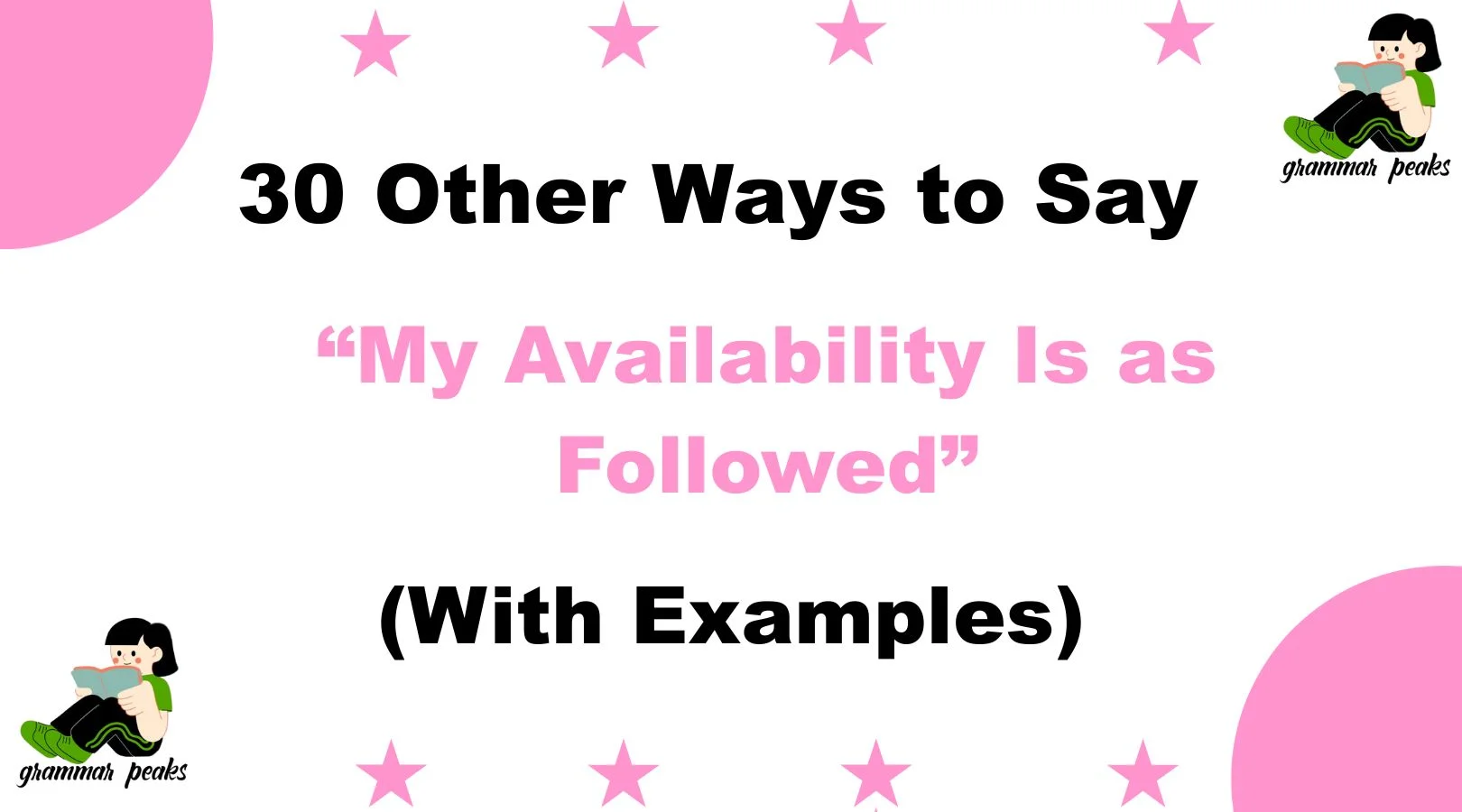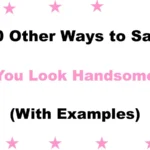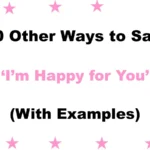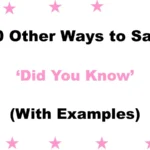Finding the right words to express your availability can truly make a difference in how your message is received. Instead of sounding too formal or mechanical, using thoughtful and caring phrasing helps your communication feel personal and genuine.
Whether you’re arranging meetings, setting appointments, or simply letting someone know when you’re free, having a variety of ways to say “My availability is as follows” can make your message warmer and more engaging. Below, you’ll discover 30 alternative phrases, each with detailed explanations, examples, and tips on when and how to use them effectively.
What Does “My Availability Is as Followed” Mean?
The phrase “My availability is as follows” is a formal way to communicate the specific times or dates when you’re free to meet, talk, or take on responsibilities. It’s often used in emails, scheduling messages, and professional settings to provide a clear outline of when someone is accessible.
This phrase is direct and structured, helping to avoid confusion or back-and-forth when coordinating meetings or tasks. However, while effective, it can sometimes feel a little impersonal, which is why exploring more warm, thoughtful alternatives can help make your communication feel more human and engaging.
When to Use “My Availability Is as Follows”
This phrase is perfect for:
- Professional emails and business communications
- Scheduling meetings with new clients or colleagues
- Formal calendar invites
- Situations requiring clarity and precision
Avoid it when a more casual or warm tone is preferred, such as informal chats or when building rapport.
Is It Professional/Polite to Say “My Availability Is as Followed”?
Yes, it is professional and polite, especially in formal contexts. It’s respectful, clear, and provides exactly the needed information without ambiguity. However, it may sound a bit stiff in more casual or personal interactions.
Pros and Cons of Saying “My Availability Is as Follows”
Pros:
- Clear and Direct Communication
This phrase quickly tells others when you’re available—perfect for time-sensitive or formal settings. - Widely Recognized in Business Settings
It’s a standard, professionally accepted expression that works across industries and corporate levels. - Structured and Organized Tone
It signals that you’ve thoughtfully considered your schedule, showing preparedness and reliability. - Neutral and Non-Offensive
The phrase is neutral in tone, reducing the risk of sounding overly casual or too assertive.
Cons:
- Can Sound Robotic or Impersonal
While clear, it may come across as cold or overly formal, especially in casual or friendly settings. - Lacks Warmth or Human Touch
It doesn’t convey empathy or personality, which may be important in client or team communications. - May Be Too Formal for Some Audiences
Using it with peers, freelancers, or creative collaborators might make the tone feel stiff or distant. - Overused in Emails
Because it’s common, it can feel repetitive or templated, reducing the uniqueness of your message.
Synonyms for “My Availability Is as Follows”
- Here are the times I’m available
- I’m free at the following times
- These are the windows I have open
- My schedule looks like this
- I can make time during these slots
- You can reach me at these times
- I’m open at the following hours
- Here’s when I’m free
- I’m available at these times
- Below are my open times
- My open slots include
- These are my free periods
- You can catch me at these times
- I’m accessible during
- My timetable is open at
- I’m reachable at
- Feel free to contact me during
- I’m at your disposal at
- You can connect with me at
- My hours of availability are
- Here’s when I can be reached
- I’m free to meet on
- The following times work for me
- I’m flexible at
- My open calendar slots are
- I’ve set aside these times
- Here’s my availability window
- I’m scheduled to be free on
- These time frames suit me
- My open times are as follows
1. Here are the times I’m available
Definition: A friendly, straightforward way to share your free times.
Explanation: Slightly less formal, it sounds welcoming and easy-going.
Example: “Here are the times I’m available: Monday 10 AM – 12 PM, Wednesday 3 PM – 5 PM.”
Best Use: Casual professional emails or internal team communication.
Worst Use: Very formal or initial client contact emails.
Tone: Warm, clear, approachable.
2. I’m free at the following times
Definition: Indicates openness in a casual but clear manner.
Explanation: Conveys availability with a gentle, conversational touch.
Example: “I’m free at the following times: Tuesday 2 PM – 4 PM, Thursday 9 AM – 11 AM.”
Best Use: When writing to colleagues or familiar clients.
Worst Use: Formal documents or proposals.
Tone: Friendly, professional.
3. These are the windows I have open
Definition: Slightly more informal, referring to “windows” of time.
Explanation: Adds a bit of personality to the message while staying clear.
Example: “These are the windows I have open: Friday 1 PM – 3 PM, Saturday 10 AM – 12 PM.”
Best Use: Internal communication, teams, or casual client interactions.
Worst Use: Strictly formal or legal communications.
Tone: Casual, personable.
4. My schedule looks like this
Definition: A way to present your planned free times in an organized manner.
Explanation: Gives a sense of planning and readiness.
Example: “My schedule looks like this for next week: Monday 9 AM – 11 AM, Wednesday 2 PM – 5 PM.”
Best Use: When sharing availability in meetings or planning emails.
Worst Use: Overly formal business introductions.
Tone: Professional, conversational.
5. I can make time during these slots
Definition: Shows flexibility and willingness to accommodate.
Explanation: Implies readiness to prioritize the recipient’s needs.
Example: “I can make time during these slots: Tuesday 11 AM – 1 PM, Thursday 3 PM – 4 PM.”
Best Use: Scheduling with clients or supervisors when flexibility is key.
Worst Use: When no flexibility exists.
Tone: Polite, accommodating.
6. You can reach me at these times
Definition: A polite way to inform someone when you’re contactable.
Explanation: It implies you’re open to communication and encourages interaction.
Example: “You can reach me at these times: Wednesday 10 AM – 12 PM and Friday after 3 PM.”
Best Use: When inviting others to contact you directly.
Worst Use: Group scheduling or third-party communications.
Tone: Approachable, responsive.
7. I’m open at the following hours
Definition: A direct and friendly way to share your availability.
Explanation: It maintains clarity while sounding a bit more conversational.
Example: “I’m open at the following hours: Monday 1 PM – 4 PM.”
Best Use: Internal meetings or team check-ins.
Worst Use: In emails to high-level executives.
Tone: Simple, easygoing.
8. Here’s when I’m free
Definition: A short, relaxed phrase for offering your free time.
Explanation: Ideal for informal or team-based communication.
Example: “Here’s when I’m free: Thursday after 2 PM, Friday morning.”
Best Use: Casual or collaborative settings.
Worst Use: Legal or formal business correspondence.
Tone: Light, friendly.
9. I’m available at these times
Definition: Clear and direct way to express availability.
Explanation: Slightly more casual than the original phrase, yet still polite.
Example: “I’m available at these times: Tuesday 10 AM – 12 PM and Thursday 2 PM – 3 PM.”
Best Use: Emails to clients or colleagues.
Worst Use: When a more personal tone is needed.
Tone: Clear, semi-formal.
10. Below are my open times
Definition: A structured way to present your availability.
Explanation: Keeps the message neat and professional.
Example: “Below are my open times: Monday 2 PM – 4 PM, Friday before noon.”
Best Use: Coordinating meetings with teams or external contacts.
Worst Use: Text messages or instant messaging platforms.
Tone: Organized, respectful.
11. My open slots include
Definition: Indicates specific free time periods.
Explanation: A casual variation that shows readiness to coordinate.
Example: “My open slots include Wednesday morning and Friday after 3 PM.”
Best Use: Scheduling with coworkers or peers.
Worst Use: Emails to executives or unfamiliar clients.
Tone: Collaborative, clear.
12. These are my free periods
Definition: Highlights available times in your calendar.
Explanation: Common in academic or structured work environments.
Example: “These are my free periods: Tuesday 1 PM – 3 PM.”
Best Use: In education or team-based projects.
Worst Use: With clients or formal negotiations.
Tone: Informative, neutral.
13. You can catch me at these times
Definition: Informal way of offering availability.
Explanation: Feels relaxed and easygoing, great for friendly chats.
Example: “You can catch me at these times: Monday afternoon, Wednesday before lunch.”
Best Use: Informal messages or among teammates.
Worst Use: Professional proposals or job applications.
Tone: Friendly, casual.
14. I’m accessible during
Definition: Indicates times you are open and reachable.
Explanation: Slightly more formal and respectful in tone.
Example: “I’m accessible during: Thursday 10 AM – 12 PM.”
Best Use: Polished but approachable business communications.
Worst Use: Text messages or short-form chats.
Tone: Professional, composed.
15. My timetable is open at
Definition: Indicates flexibility in your schedule.
Explanation: Suggests that your current schedule allows room at specific times.
Example: “My timetable is open at 11 AM Tuesday and 4 PM Friday.”
Best Use: Semi-formal business emails or academic settings.
Worst Use: Extremely informal contexts.
Tone: Balanced, organized.
16. I’m reachable at
Definition: Communicates when someone can expect a reply or contact.
Explanation: Suggests availability for communication, especially virtually.
Example: “I’m reachable at 2 PM or after 5 PM tomorrow.”
Best Use: Phone or virtual meeting arrangements.
Worst Use: Physical meeting scheduling.
Tone: Accessible, direct.
17. Feel free to contact me during
Definition: Invites communication with politeness.
Explanation: Emphasizes approachability and openness.
Example: “Feel free to contact me during 10 AM – 12 PM on Tuesday.”
Best Use: Customer service or client-based conversations.
Worst Use: High-level or extremely formal proposals.
Tone: Warm, customer-friendly.
18. I’m at your disposal at
Definition: A highly polite way of offering availability.
Explanation: Often used in formal or service-oriented contexts.
Example: “I’m at your disposal at any time after 1 PM today.”
Best Use: High-end service industries, diplomacy, or executive outreach.
Worst Use: Casual or peer-level exchanges.
Tone: Elegant, formal.
19. You can connect with me at
Definition: Suggests a time for direct interaction.
Explanation: Modern and suitable for digital communications.
Example: “You can connect with me at 3 PM today or anytime Thursday morning.”
Best Use: Online meetings, remote teams.
Worst Use: Legal or highly traditional correspondence.
Tone: Contemporary, friendly.
20. My hours of availability are
Definition: Offers a structured look at your schedule.
Explanation: Polite and professional while still personal.
Example: “My hours of availability are 9 AM – 11 AM and 2 PM – 4 PM.”
Best Use: Job interviews or B2B meetings.
Worst Use: Text or chat platforms.
Tone: Clear, businesslike.
21. Here’s when I can be reached
Definition: Tell others when you’re open for contact.
Explanation: Keeps the tone warm while being precise.
Example: “Here’s when I can be reached: Monday between 10 and 12.”
Best Use: One-on-one client or team interactions.
Worst Use: Public announcements.
Tone: Personable, clear.
22. I’m free to meet on
Definition: Suggests availability for meetings specifically.
Explanation: Great for direct meeting requests.
Example: “I’m free to meet on Tuesday or Friday morning.”
Best Use: Scheduling in professional settings.
Worst Use: Open-ended or vague messages.
Tone: Professional, straightforward.
23. The following times work for me
Definition: Let others know which time slots are good for you.
Explanation: Shows mutual respect for shared availability.
Example: “The following times work for me: Wednesday 11 AM, Friday 3 PM.”
Best Use: Collaborative scheduling.
Worst Use: Very formal outreach.
Tone: Considerate, cooperative.
24. I’m flexible at
Definition: Indicates openness around certain timeframes.
Explanation: Offers availability while signaling willingness to adapt.
Example: “I’m flexible at around 10 AM or 2 PM.”
Best Use: Scheduling with teammates or clients.
Worst Use: Strict or deadline-sensitive conversations.
Tone: Flexible, friendly.
25. My open calendar slots are
Definition: Direct reference to your calendar availability.
Explanation: Modern and efficient, especially when using calendar tools.
Example: “My open calendar slots are Tuesday 9–11 AM and Thursday 3–5 PM.”
Best Use: Digital or shared calendar setups.
Worst Use: Non-digital conversations.
Tone: Tech-savvy, structured.
26. I’ve set aside these times
Definition: Suggests you’ve prioritized availability.
Explanation: Communicates commitment and consideration.
Example: “I’ve set aside these times: Friday morning, Monday afternoon.”
Best Use: Client calls or mentorship conversations.
Worst Use: Inflexible or large-group meetings.
Tone: Caring, intentional.
27. Here’s my availability window
Definition: Offers a bounded period of availability.
Explanation: Best when you want to give a specific timeframe.
Example: “Here’s my availability window: 2 PM – 4 PM on Wednesday.”
Best Use: Interviews for medical appointments.
Worst Use: Open-ended invitations.
Tone: Clear, respectful.
28. I’m scheduled to be free on
Definition: Indicates a time that’s already set aside.
Explanation: Shows that your availability is planned and secure.
Example: “I’m scheduled to be free on Thursday from 1 PM.”
Best Use: Coordinating in advance.
Worst Use: Unplanned or spontaneous meetings.
Tone: Precise, forward-thinking.
29. These time frames suit me
Definition: Suggests the times are optimal for you.
Explanation: Offers your preferred windows of availability.
Example: “These time frames suit me: Tuesday late morning, Friday after 3 PM.”
Best Use: When offering suggestions.
Worst Use: Strictly assigned schedules.
Tone: Balanced, polite.
30. My open times are as follows
Definition: A more conversational version of the original phrase.
Explanation: Feels a bit softer, while still clear.
Example: “My open times are as follows: Monday 1–3 PM, Wednesday morning.”
Best Use: General use with teams or clients.
Worst Use: Slang-heavy or informal chats.
Tone: Clear, kind.
Conclusion
The phrase “My availability is as follows” is widely accepted, but when you want to make a stronger human connection, using alternatives that are empathetic, thoughtful, and situation-appropriate can make all the difference. Whether you’re aiming to sound more casual, more respectful, or more accommodating, this list of 30 alternatives ensures you’re always saying it in a way that resonates—clearly, kindly, and professionally.
FAQs
1. What is a more polite way to say “My availability is as follows”?
A more polite and warm alternative would be:
“Feel free to contact me during…” or “I’m available at these times…”
These options sound more inviting and respectful, especially in professional or client-facing messages.
2. Can I use casual alternatives in formal emails?
It depends on your audience. While phrases like “Here’s when I’m free” or “You can catch me at these times” are friendly, they may not be suitable in highly formal or executive-level communications. For formal settings, stick with:
“I’m available at the following times” or “My hours of availability are…”
3. Is “My availability is as follows” considered outdated?
Not exactly—it’s still widely accepted in business communication. However, it can sound a bit robotic or impersonal. If you want to sound more approachable or human, using softer alternatives can enhance connection and clarity.
4. What are some alternatives that sound friendly but still professional?
Here are a few great professional yet warm alternatives:
- “I’m reachable at…”
- “These time frames suit me…”
- “Feel free to reach out during…”
These phrases strike a balance between clarity and kindness.
5. Which alternatives are best for client communication?
For client communication, focus on being both clear and courteous. Ideal phrases include:
- “Here’s when I can be reached”
- “I’ve set aside these times for you”
- “You can connect with me at…”
These expressions show you’re organised, attentive, and easy to work with.

Mia Rose is a passionate Language Coach and Contributor at GrammarPeaks, where she specializes in practical grammar tips and language learning strategies. With a strong foundation in education and communication, Mia brings a friendly, approachable style to her writing. Her goal is to make complex grammar rules simple and usable for learners at any level, helping them grow in both confidence and fluency.





